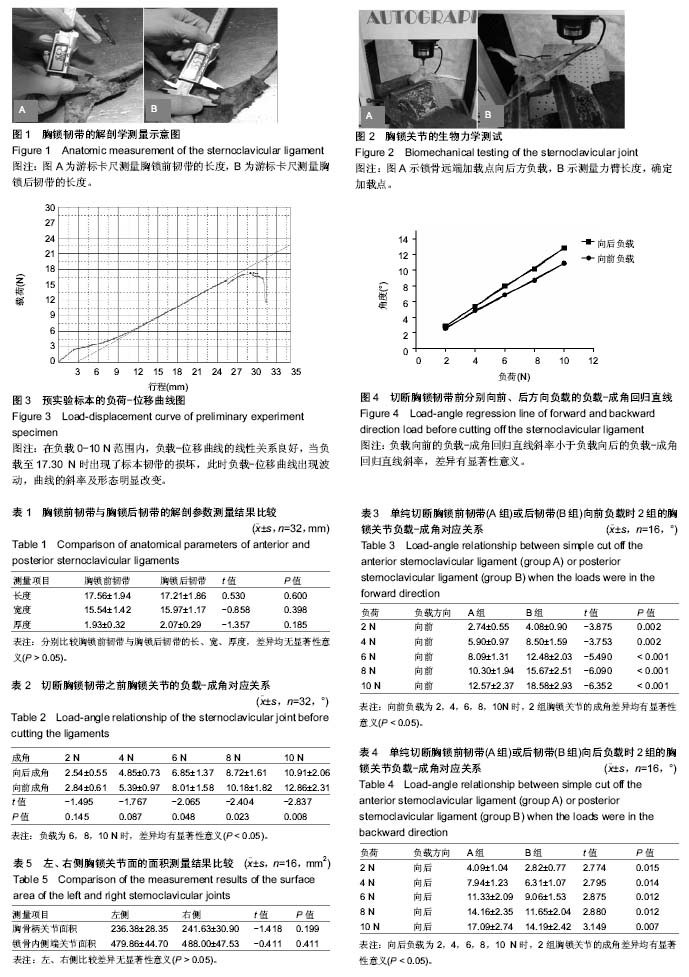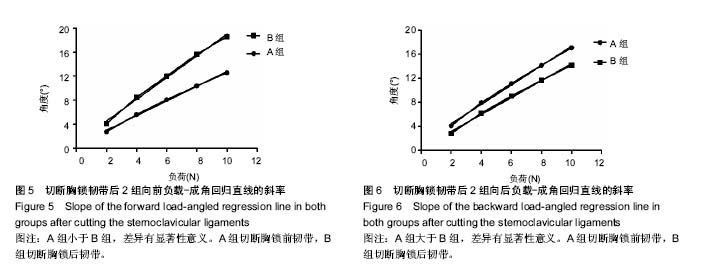中国组织工程研究 ›› 2018, Vol. 22 ›› Issue (11): 1695-1700.doi: 10.3969/j.issn.2095-4344.0165
• 骨与关节生物力学 bone and joint biomechanics • 上一篇 下一篇
胸锁关节的解剖学及生物力学特征
杨 琨1,吴天昊1,李 根1,阳运康2,葛建华2,白 蕊3,向飞帆3,孙远林3
- 1泸州市人民医院骨科,四川省泸州市 646000;2西南医科大学附属医院骨与关节外科,四川省泸州市 646000;3西南医科大学,四川省泸州市 646000
Anatomical and biomechanical characteristics of sternoclavicular joint
Yang Kun1, Wu Tian-hao1, Li Gen1, Yang Yun-kang2, Ge Jian-hua2, Bai Rui3, Xiang Fei-fan3, Sun Yuan-lin3
- 1Department of Orthopedics, Luzhou People’s Hospital, Luzhou 646000, Sichuan Province, China; 2Bone and Joint Surgery, Affiliated Hospital of Southwest Medical University, Luzhou 646000, Sichuan Province, China; 3Southwest Medical University, Luzhou 646000, Sichuan Province, China
摘要:
文章快速阅读:
.jpg)
文题释义:
胸锁关节:由锁骨的胸骨关节面与胸骨柄的锁骨切迹及第1肋软骨的上面共同构成,上肢骨与躯干骨连结的唯一关节。可协同完成肩胛带各个方向的微动运动,体现为锁骨外侧端的上提、下降和前后运动,此外,尚能做轻微的旋转运动。
生物力学:研究生命体运动和变形的学科,通过生物学与力学原理方法的有机结合,认识生命过程的规律,解决生命与健康领域的科学问题。应用力学原理和方法研究生物体在外界力和内部受控的肌力作用下的机械运动规律。中国的生物力学研究起步较晚,人体运动学数据库还不是很完善,深入研究人体关节的生物力学行为具有十分重要的现实意义。
摘要
背景:临床治疗胸锁关节脱位及周围骨折的经验相对缺乏,然而其发病率有逐年增加的趋势,目前国内外关于胸锁关节解剖及生物力学的研究甚少,尚无有关胸锁关节系统性解剖测量的报道。
目的:通过对胸锁关节的解剖学及生物力学研究,为胸锁关节脱位及周围骨折的临床诊治提供生物学参考。
方法:①选取16具(32侧)成人防腐、湿润尸体标本,解剖分离出完整的胸骨柄、双侧锁骨及胸锁关节周围组织,修整成骨-韧带-骨标本模型;②用墨迹图结合网格计数法测量胸锁关节标本的胸骨柄与锁骨端关节面积;③观察标本胸锁前、后韧带的形态学特点,分别测量长、宽及厚度,并进行统计学分析;④将每副标本的左、右侧胸锁关节随机配对分成2组:A组拟行单纯切断胸锁前韧带,B组拟行单纯切断后韧带。切断韧带前后,在解剖位均以相同力臂长度,垂直于锁骨远端进行前、后方向负载实验。比较2组在前、后方向负载下关节所成的角度及负载-成角回归直线斜率。
结果与结论:①胸骨柄关节面积(239.00±28.78) mm2小于锁骨内侧端关节面积(482.56±44.89) mm2,差异有显著性意义(t=-40.105,P < 0.001);②胸锁前韧带长度为(17.56±1.94) mm,宽度为(15.54±1.42) mm,厚度为(1.93±0.32) mm。胸锁后韧带长度为(17.21±1.86) mm,宽度为(15.97±1.17) mm,厚度为(2.07±0.29) mm。分别比较两者的长、宽、厚度差异均无显著性意义(P > 0.05);③2组标本切断韧带之前,负荷为2,4,6,8,10 N时,负载向前导致关节向后的成角均小于负载向后导致关节向前的成角,但仅在负荷为6,8,10 N时,差异有显著性意义(P < 0.05);负载向前的负载-成角回归直线斜率小于负载向后,差异有显著性意义(F=31.413,P=0.001);切断韧带后,2组向前负载2,4,6,8,10 N时,A组关节向后的成角均小于B组(P < 0.05),A组负载-成角回归直线斜率小于B组(F=52.224,P < 0.001);2组向后负载2,4,6,8,10 N时,A组关节向前的成角均大于B组(P < 0.05),A组负载-成角回归直线斜率大于B组(F=12.503,P=0.008);④结果提示,锁骨内侧端关节面与胸骨柄关节面的接触面狭小,关节本身不稳定,胸锁韧带对于维持关节稳定性的作用极为重要;胸锁韧带限制关节向前成角的作用弱于向后成角,关节在解剖位时向前自然成角,胸锁关节易发生前脱位;在手术治疗胸锁关节脱位及周围骨折时应重视胸锁韧带的修复与重建。
中图分类号:


.jpg)